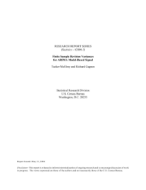
An official website of the United States government
Here’s how you know
Official websites use .gov
A .gov website belongs to an official government organization in the United States.
Secure .gov websites use HTTPS
A lock (
) or https:// means you’ve safely connected to the .gov website. Share sensitive information only on official, secure websites.
-
//
- Census.gov /
- Library /
- Census Working Papers /
- Finite Sample Revision Variances for ARIMA Model-Based Signal Extra...
Finite Sample Revision Variances for ARIMA Model-Based Signal Extraction
Finite Sample Revision Variances for ARIMA Model-Based Signal Extraction
Abstract
We consider properties of revisions to mean square optimal concurrent estimates of unobserved components, e.g., seasonal adjustments or trends, obtained by ARIMA model-based signal extraction methods like those used by SEATS. Concurrent estimates, i.e., the estimate for the most recent month (or quarter), are updated whenever future observations become available, and the difference between the concurrent estimate and the mean square optimal update is called the revision. It is therefore of interest to measure the variance of the revisions, which generally increase in size as more data becomes available; this is because the signal extraction mean squared error decreases as more observations are added. In this paper we compute the variance of the revision based on a finite sample of data, where the revision lead, i.e., the amount of additional data that becomes available, is potentially infinite. The revision variance for the infinite revision lead represents the maximal revision variance possible, and is useful as a normalization. Our focus is on presenting practical, easily coded algorithms for computation of the revision variances. These make possible a finite sample-based alternative to SEATS’ “percentage reduction in the standard error of the revision after additional years,” which assumes that estimates are obtained using an infinite past. We present numerical comparisons between SEATS’ diagnostic and our finite sample analogue.
Others in Series
Research
Working Paper
Working Paper
Share
Related Information
Some content on this site is available in several different electronic formats. Some of the files may require a plug-in or additional software to view.
 Yes
Yes
 No
NoComments or suggestions?


Top

